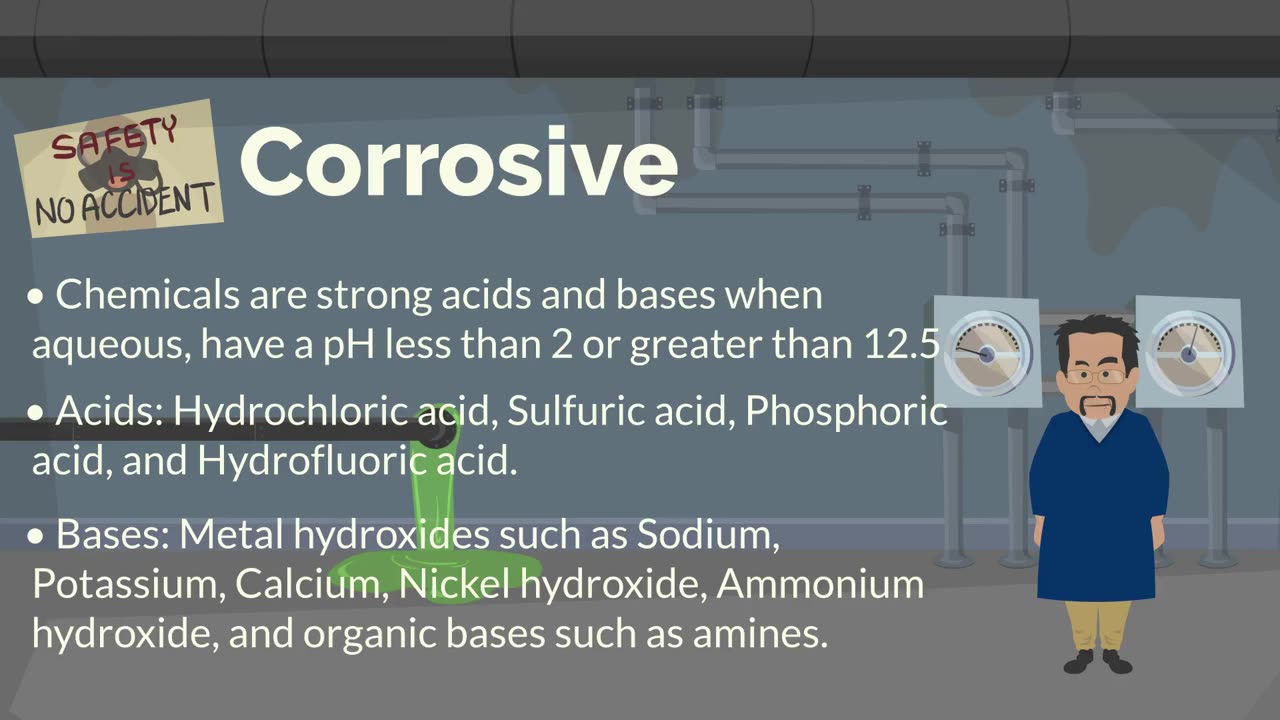Premium Only Content

Chemical Hazard Recognition_ TRIC
**Chemical Hazard Recognition: TRIC**
The acronym **TRIC** can be used as a systematic approach to recognize and address chemical hazards. It stands for **Toxicity, Reactivity, Ignitability, and Corrosivity**. Here's how each component helps in chemical hazard recognition:
---
### **1. Toxicity**
- **Definition**: The potential of a chemical to cause harm to living organisms through inhalation, ingestion, or skin contact.
- **Indicators**:
- Pictograms or labels indicating "Toxic," "Harmful," or "Dangerous."
- Consult the Safety Data Sheet (SDS) for information on lethal doses (LD50) and permissible exposure limits (PEL).
- **Recognition**:
- Examples: Carbon monoxide, cyanide, and pesticides.
- Observe symptoms like dizziness, nausea, or irritation.
---
### **2. Reactivity**
- **Definition**: The chemical's tendency to react violently or release energy when exposed to certain conditions (e.g., heat, water, or other chemicals).
- **Indicators**:
- Terms like "Unstable," "Explosive," or "Reactive" on labels.
- SDS section on stability and reactivity.
- **Recognition**:
- Examples: Sodium reacts with water; peroxides are shock-sensitive.
- Look for storage warnings like "Keep away from heat or incompatible substances."
---
### **3. Ignitability**
- **Definition**: The ability of a chemical to catch fire under certain conditions.
- **Indicators**:
- Flashpoint data on the SDS.
- Flammable or combustible warnings.
- Pictograms like the flame symbol.
- **Recognition**:
- Examples: Gasoline, ethanol, and acetone.
- Check for proper grounding and storage in fire-safe cabinets.
---
### **4. Corrosivity**
- **Definition**: The ability of a chemical to destroy or irreversibly damage materials, including skin and metals.
- **Indicators**:
- Pictograms or warnings indicating "Corrosive."
- SDS sections on handling precautions.
- **Recognition**:
- Examples: Sulfuric acid, sodium hydroxide, and hydrochloric acid.
- Observe physical signs of damage to containers or PPE.
---
### **Application of TRIC in Safety**
1. **Assessment**: Use TRIC to evaluate the potential risks of chemicals during storage, transportation, and usage.
2. **Training**: Educate employees about recognizing hazards and understanding labels and SDS.
3. **Controls**: Implement engineering controls (e.g., fume hoods), administrative controls (e.g., safe work practices), and PPE to mitigate risks.
Would you like this concept expanded into a training presentation or animation script?
-
 6:43
6:43
HSESafetyInformation
7 months agoLahori Chanay Recipe - Lahori Cholay Recipe - Chana Chana Masala
57 -
 1:28:26
1:28:26
Steven Crowder
7 hours agoThe Left is Violent | Change My Mind
544K1.53K -
 LIVE
LIVE
StoneMountain64
4 hours agoI played BLACK OPS 7, is "Call of duty BACK"?
95 watching -
 DVR
DVR
Stephen Gardner
52 minutes ago🔥SHOCKING Aftermath: Charlie Kirk FBI update + Is Candace Owens Helping Or Hurting?
10 -
 1:44:21
1:44:21
The Quartering
3 hours agoToday's Breaking News!
94.5K57 -
 5:17
5:17
Buddy Brown
1 day ago $1.27 earnedSomething BIBLICAL is Happening with the Earth's FREQUENCY! | Buddy Brown
8.23K11 -
![[Ep 760] Schumer’s Shutdown & Sombrero-Gate | Obama Library, Tides Foundation, & Terrorists](https://1a-1791.com/video/fwe2/fa/s8/1/4/f/5/m/4f5mz.0kob-small-Ep-760-Schumers-Shutdown-an.jpg) LIVE
LIVE
The Nunn Report - w/ Dan Nunn
2 hours ago[Ep 760] Schumer’s Shutdown & Sombrero-Gate | Obama Library, Tides Foundation, & Terrorists
195 watching -
 LIVE
LIVE
Film Threat
21 hours agoBATTLING COMMENTS ABOUT ONE BATTLE AFTER ANOTHER: HOLLYWOOD IS AT WAR | Hollywood on the Rocks
68 watching -
 1:33:23
1:33:23
The HotSeat
1 hour agoPope Blesses a Hunk of Ice + The Govt is SHUTDOWN!!!
5.63K10 -
 3:12:38
3:12:38
Right Side Broadcasting Network
7 hours agoLIVE REPLAY: White House Press Secretary Karoline Leavitt Holds a Press Briefing - 10/1/25
119K58